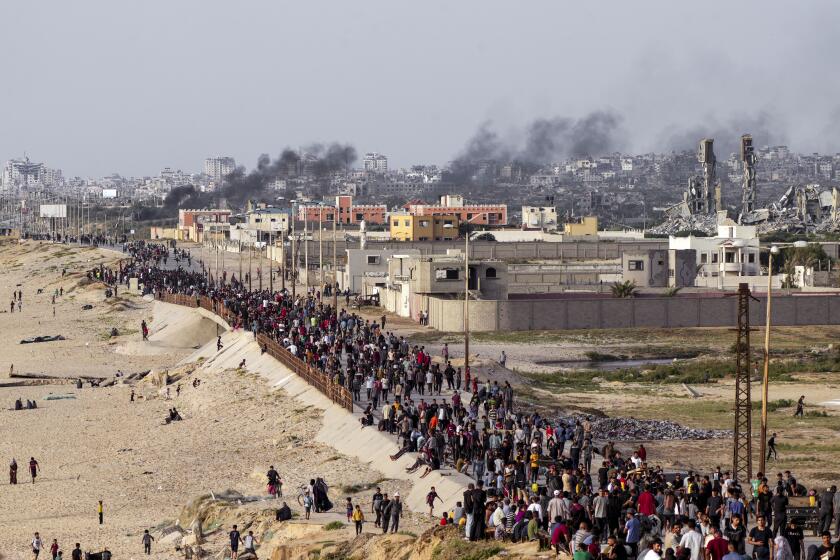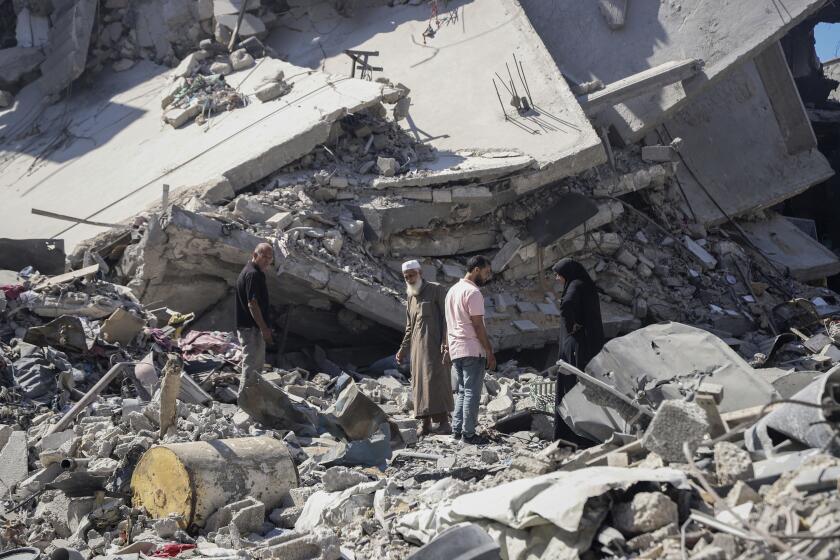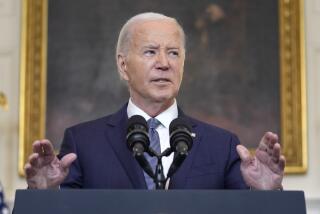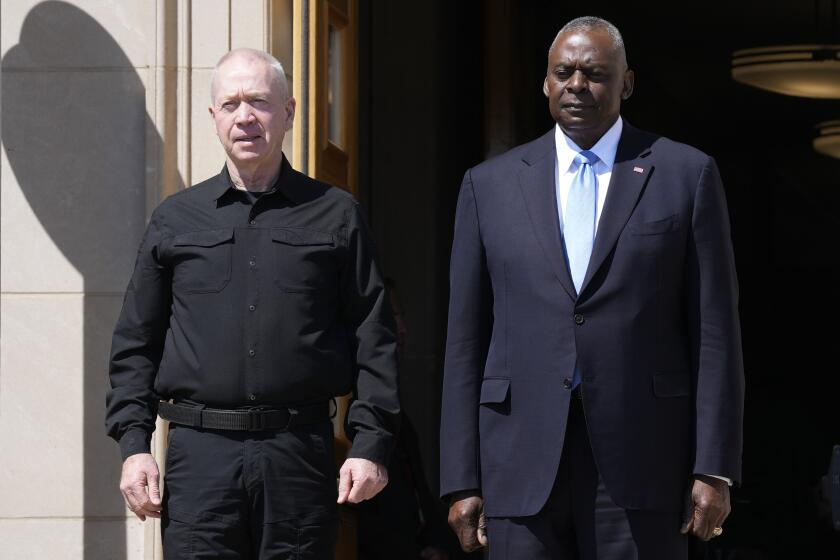Hamas seeks changes to Gaza cease-fire plan. U.S. ‘evaluating’ the response

Hamas said Tuesday that it gave mediators its reply to the U.S.-backed proposal for a cease-fire in Gaza, seeking some “amendments” on the deal. It appeared the reply was short of an outright acceptance that the United States has been pushing for but kept negotiations alive over an elusive halt to the eight-month war.
The foreign ministries of Qatar and Egypt — which have been key mediators alongside the United States — confirmed that they had received Hamas’ response and said mediators were studying it.
“We’re in receipt of this reply that Hamas delivered to Qatar and to Egypt, and we are evaluating it right now,” White House national security spokesman John F. Kirby told reporters in Washington.
Hamas spokesman Jihad Taha said the response included “amendments that confirm the cease-fire, withdrawal, reconstruction and [prisoner] exchange.” Taha did not elaborate.
But while supporting the broad outlines of the deal, Hamas officials have expressed wariness over whether Israel would implement its terms, particularly provisions for an eventual permanent end to fighting and full Israeli withdrawal from Gaza in return for the release of all hostages held by the militants.
Even as the U.S. has said Israel accepted the proposal, Israeli Prime Minister Benjamin Netanyahu has given conflicting signals, saying Israel will not stop until its its goal of destroying Hamas is achieved.
U.S. Secretary of State Antony J. Blinken has been in the region this week trying to push through the deal — his eighth visit since Hamas’ Oct. 7 attack on southern Israel ignited Israel’s offensive in Gaza. On Tuesday, Blinken continued pressure on Hamas to accept the proposal, saying that the U.N. Security Council’s vote in favor of a U.S.-backed proposal for a Gaza cease-fire and hostage release made it “as clear as it possibly could be” that the world supports the plan.
“Everyone’s vote is in, except for one vote, and that’s Hamas,” Blinken told reporters in Tel Aviv after meeting with Israeli officials. He said Netanyahu had reaffirmed his commitment to the proposal when they met late Monday.
In a joint statement announcing that they had submitted their reply to Qatar and Egypt, Hamas and the smaller Islamic Jihad militant group said they were ready to “deal positively to arrive at an agreement” and that their priority is to bring a “complete stop” to the war. A senior Hamas official, Osama Hamdan, told Lebanon’s Al Mayadeen television that the group had “submitted some remarks on the proposal to the mediators,” without elaborating.
The proposal has raised hopes of ending an eight-month conflict in which Israel’s bombardment and ground offensives in Gaza have killed more than 36,000 Palestinians, according to Palestinian health officials, and driven some 80% of the population of 2.3 million from their homes. Israeli restrictions and ongoing fighting have hindered efforts to bring humanitarian aid to the isolated coastal enclave, fueling widespread hunger.
Israel launched its campaign, vowing to eliminate Hamas, after the group and other militants stormed into Israel on Oct. 7, killing some 1,200 people, mostly civilians, and taking around 250 hostage. More than 100 hostages were released during a weeklong cease-fire last year in exchange for Palestinians imprisoned by Israel.
Blinken met privately with families of the hostages as well as demonstrators outside a hotel calling for a cease-fire deal. Blinken was in Cairo on Monday and is expected to stop in Qatar on this trip.
Later on Tuesday, Blinken attended a Gaza aid conference in Jordan, where he announced more than $400 million in additional aid for Palestinians in Gaza and the wider region, bringing the total U.S. assistance to more than $674 million over the last eight months.
U.N. Secretary-General António Guterres told the gathering that the amount of aid flowing to the United Nations in Gaza for distribution has plummeted by two-thirds since Israel launched an offensive in the territory’s southern city of Rafah in early May.
Guterres called for all border crossings to be opened, saying, “the speed and scale of the carnage and killing in Gaza” is beyond anything he has since he took the helm of the U.N. in 2017.
In a separate development, the U.N. human rights office said Israeli forces and Palestinian militants may have committed war crimes during the deadly Israeli raid that rescued four hostages over the weekend. At least 274 Palestinians were killed in the operation, according to Gaza’s Health Ministry.
There’s been no firm public response yet from Hamas or Israel to the U.S.-backed cease-fire proposal they received 10 days ago.
On Monday, the U.N. Security Council voted overwhelmingly to approve the cease-fire proposal, with 14 of the 15 members voting in favor and Russia abstaining. The resolution calls on Israel and Hamas “to fully implement its terms without delay and without condition.”
The Security Council resolution calls for a cease-fire only until Ramadan ends. But it’s a key building block for serious negotiations with Israel and Hamas.
Most postwar plans floated by diplomats and world leaders seem doomed to fail. Here’s a look at the leading ideas for what to do with the Gaza Strip.
Biden’s May 31 announcement of the new proposal said the three-phase plan would begin with an initial six-week cease-fire and the release of some hostages in exchange for Palestinian prisoners. Israeli forces would withdraw from populated areas and Palestinian civilians would be allowed to return to their homes.
Phase 1 also requires the safe distribution of humanitarian assistance “at scale throughout the Gaza Strip,” which Biden said would lead to 600 trucks with aid entering Gaza every day.
In Phase 2, the resolution says that with the agreement of Israel and Hamas, “a permanent end to hostilities, in exchange for the release of all other hostages still in Gaza, and a full withdrawal of Israeli forces from Gaza” will take place. Hamas is still holding around 120 hostages or hostage bodies.
Phase 3 would launch “a major multiyear reconstruction plan for Gaza and the return of the remains of any deceased hostages still in Gaza to their families.”
Families of Israeli hostages held by Hamas call on all parties to immediately accept a proposal detailed by President Biden to end the war in Gaza.
Hamas embraced a similar proposal last month that was rejected by Israel.
Biden presented the latest as an Israeli proposal, but Netanyahu has publicly disputed key aspects of it, saying there were parts left out by Biden.
The conflicting signals from Netanayahu appear to reflect the political dilemma he is facing. His far-right coalition allies have rejected the proposal and have threatened to bring down his government if he ends the war without destroying Hamas.
A lasting cease-fire and the withdrawal of Israeli forces from Gaza would likely allow Hamas to retain control of the territory and rebuild its military capabilities, it is believed.
But Netanyahu is also under mounting pressure to accept a deal to bring the hostages back. Thousands of Israelis, including families of the hostages, have demonstrated in favor of the U.S.-backed plan.
The transition from the first to the second phase appears to be a sticking point. Hamas wants assurances that Israel will not resume the war, and Israel wants to ensure that protracted negotiations over the second phase do not prolong the cease-fire indefinitely while leaving hostages in captivity.
Blinken said the proposal would bring an immediate cease-fire and commit the parties to negotiate an enduring one. “The cease-fire that would take place immediately would remain in place, which is manifestly good for for everyone,” Blinken said. “And then we’ll have to see.”
Lee and Sewell write for the Associated Press. Sewell reported from Beirut.
More to Read
Start your day right
Sign up for Essential California for news, features and recommendations from the L.A. Times and beyond in your inbox six days a week.
You may occasionally receive promotional content from the Los Angeles Times.










